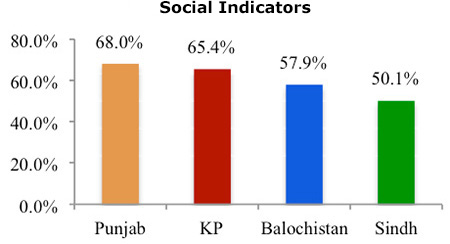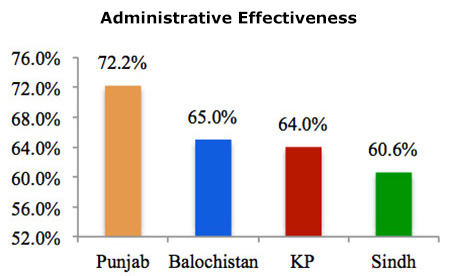
Khyber
Pakhtunkhwa (KP) Ties with Punjab for First Position in Quality of Governance
at 68%; Sindh Ranks Second at 59% and Balochistan Comes in Last at 58%; PILDAT
Releases Provincial Score Cards on Quality of Governance for 2014-2015
Highlights
- KP and Punjab secure first position in the comparative
score card on overall quality of governance at 68%, Sindh ranks second
at 59%, followed by Balochistan at 58%.

- According to PILDAT’s Governance Assessment in
the first year (2013-2014), Punjab was ranked first at 42% followed by
KP at 37%, while Balochistan and Sindh had tied for third place at 34%
each.
- PILDAT’s Score Cards are based on the change (improvement,
deterioration or no-change) in the quality of governance between the first
(2013-2014) and the second (2014-2015) years of the Governments in office
after May 2013 General Elections.
- The Assessment is based on 25 Governance Assessment Parameters
(GAPs), under 5 Pillars of Governance: Rule of Law, Management of Economy,
Social Indicators, Service Delivery and Administrative Effectiveness.
- KP stands 1st in Rule of Law, Management of Economy and
Service Delivery; while Punjab leads in Administrative Effectiveness and
Social Indicators.





- Parameters garnering a score of more than 50% are indicative
of performance improvement from 2013-2014 to 2014-2015:
- Khyber Pakhtunkhwa and the Punjab Government’s
performance improved in all 25 parameters assessed
- The Government of Balochistan’s performance improved
in 20 parameters, deteriorated in 4, and remained stagnant in 1 parameter.
- The Government of Sindh’s performance improved
in 20 parameters, deteriorated in 4 and remained stagnant in 1 parameter.
- The highest and lowest scored Governance Assessment Parameters
for each Province in the second year of the Governments (2014-2015):
- KP scored the highest in Environmental Sustainability
(82.3%) and the lowest in Gender Gap (51%)
- Punjab scored the highest in Poverty Alleviation (80.4%)
and the lowest in Gender Gap (52.9%)
- Balochistan garnered the highest score for Devolution
of Powers to Local Governments (77.7%) and the lowest in Public Transport
(41.3%)
- Sindh scored the highest in Public Transport (78.3%)
and the lowest in Gender Gap (38.6%)
March 31: PILDAT analysis reveals that Quality
of Governance in Pakistan’s Provinces is improving slowly and gradually.
The Provincial Government of Khyber Pakhtunkhwa (KP) closed the gap with the
Government of Punjab as both received an overall score of 68%
in their performance on quality of governance in the second year of the Governments,
since assuming office in 2013.
There is more to the good news- Government
of Punjab and Khyber Pakhtunkhwa received a positive score (above 50%) for
all 25 parameters assessed. Whereas, the Government of Sindh and Balochistan
performed positively across 20 parameters, while performance deteriorated
in 4 and remained stagnant in 1.
KP leads in Environmental Sustainability
at 82.3% while Punjab is the leader under the parameter on Poverty
Alleviation at 80.4%. The performance of both the KP and
Punjab Governments has been lowest in the parameter on Gender Gap
at 51% and 52.9% respectively.
According to PILDAT’s assessment, the
Sindh Government comes in third with an overall score of 59%
and Balochistan fourth at 58%. The performance of the Balochistan
Government has been highest for Devolution of Powers to Local Governments
(77.7%), being the first Province to complete its Local Government elections.
It was also the first Province to have operational Local Governments. Balochistan’s
performance is lowest in Public Transport at 41.3% for which
Sindh outperforms the remaining Provinces at 78.3%. However, according to
PILDAT’s assessment, the Sindh Government has been weakest in bridging
the Gender Gap in the Province.
The comparative analysis on quality of governance
across Pakistan’s Provinces is carried out by PILDAT since 2013 to highlight
key areas of strengths and potential areas requiring improvement in the quality
of governance.
Government of the Punjab garnered the highest
score of 84.8% for Clean Efficient and Economic Public Procurements, across
all Provinces, among all 25 Governance Assessment Parameters. Whereas, the
Government of Sindh received the lowest score of 38.5% for Gender Gap among
all parameters under consideration.
The objective behind PILDAT's initiative on
Assessment of the Quality of Governance is that as democracy progresses in
Pakistan, public focus should now be on the performance of democracy, distinct
from the process of democracy. With this Score Card, PILDAT seeks to understand
the extent to which the democratic Governments have delivered to their citizens
in terms of providing ‘Good Governance’. The initiative is by
no means an exercise to criticize the performance of the Government, but in
fact a collaborative effort intended to enable us in making informed, fact-based
assessment regarding Provinces.
Methodology Outline
For the purpose of second year assessments,
PILDAT has slightly modified its framework and scoring mechanism. Scores are
assigned on a scale of 1-5; based on the comparative performance of all Provincial
Governments. A Government gets a score above 3 for a particular indicator
if percentage change from 2013-2014 to 2014-2015 is more than the average
percentage change across all Provinces. A lower score is assigned for the
inverse. The scores, based on both policy (25% weightage) and its implementation
(75% weightage), are aggregated to arrive at overall score for the Provincial
Government, across 25 areas of governance.
The data for the Provincial Score Cards was
requested by PILDAT and was provided by the Provincial Governments. It was
supplemented with published surveys (i.e. Labor Force Survey, Pakistan Economic
Survey, PSLM etc.). Several meetings were held with Government Departments
during the process of this assessment. A draft of the analysis and Score Card
was shared with the Governments for feedback.
Comparative scores of all parameters
for the four Provincial Governments for their second year in Office (2014-2015)

Click
to view in high resolution
Colour Codes: ['Red'
= Deterioration, 'Grey' = No Change, 'Green'
= Improvement]
The complete Provincial Score Cards on Assessment
of the Quality of Governance can be accessed at: